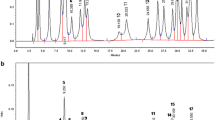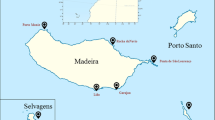Abstract
The study aims to investigate and compare the proximate composition and the fatty acid profiles of Allium orientale Boiss., Eremurus spectabilis M. Bieb., Anchusa officinalis L. and Arum elongatum Steven collected in spring 2020 and 2021. C16:0, C18:0, C18:1ω9 and C18:2ω6 were found major fatty acids in four species. Essential fatty acids C18:2ω6 (34.4 and 31.2%) and C18:3ω3 (21.4 and 16.5%) were detected significantly high in A. elongatum in both years, respectively. The proportion of toxic C22:1ω9 in E. spectabilis (4.6 and 4.1%) was found close to the danger limit (5%). The C18:1ω9 level in A. orientale (27.3 and 29.9%) and A. officinalis (33.2 and 29.51%) was significantly higher than the C18:1ω9 level in E. spectabilis and A. elongatum in both years. C24:1ω9, involved in the biosynthesis and maintenance of nerve cell myelin, was found in relatively good levels in A. orientale (2.1 and 1.9%) and A. officinalis (2.8 and 2.2%). The ∑SFA level was found to be higher in A. orientale (53.9 and 52.1%), E. spectabilis (52.4 and 55.82%) and A. officinalis (48.9 and 50.80%) compared to their ∑MUFA and ∑PUFA levels in both years. Conversely, in A. elongatum, the ∑PUFA ratio was found to be quite high (55.8 and 47.7%). The total lipid level varied between 1% and 0.4% in 2020, and 0.6% and 0.9% in 2021. Crude protein content was found to be low, around 5% on average in both years. As a result, the study clarified that although the plant fatty acid profiles are quantitatively different, they are qualitatively similar, and that the species data will also contribute to the literature and conscious consumption.
Similar content being viewed by others
References
Ceylan O, Alıc H (2015) Antibiofilm, antioxidant, antimutagenic activities and phenolic compounds of Allium orientale BOISS. Braz Arch Biol Technol 58:935–943. https://doi.org/10.1590/S1516-89132015060309
Bircan B, Kırbağ S (2015) Determination of antioxidant and antimicrobial properties of Eremurus spectabilis Bieb. Artvin Coruh Univ J For Fac 16:176–186. https://doi.org/10.17474/acuofd.63418
Tosun M, Ercisli S, Ozer H, Turan M, Polat T, Ozturk E, Padem H, Kilicgun H (2012) Chemical composition and antioxidant activity of foxtail lily (Eremurus spectabilis). Acta Sci Polon Hortorum Cultus 11:145–153
Kardaş C (2019) Muş’ta yabani bitkilerin halk hekimliğinde kullanılması [Usage of savage plants in the folk medicine in Muş]. Lokman Hekim J 9:85–96. https://doi.org/10.31020/mutftd.468848
Jaradat N, Abualhasan M (2016) Comparison of phytoconstituents, total phenol contents and free radical scavenging capacities between four Arum species from Jerusalem and Bethlehem. Pharmaceutical Sci 22:120–125. https://doi.org/10.15171/PS.2016.19
Corrêa APA, Peixoto CA, Cabral GLAG, FA (2008) Fractionation of fish oil with supercritical carbon dioxide. J Food Eng 88:381–387. https://doi.org/10.1016/j.jfoodeng.2008.02.025
Kones R, Howell S, Rumana U (2018) n-3 polyunsaturated fatty acids and cardiovascular disease: principles, practices, pitfalls, and promises-a contemporary review. Med Princ Pract 26:497–508. https://doi.org/10.1159/000485837
Johnson M, Bradford C (2014) Omega-3, omega-6 and omega-9 fatty acids: implications for cardiovascular and other diseases. J Glycom Lipidom 4:1–8. https://doi.org/10.4172/2153-0637.1000123
Çelebi Ş, Kaya H, Kaya A (2017) Effects of omega-3 fatty acids on human health. Alınteri J Agric Sci 32:105–112. https://doi.org/10.28955/alinterizbd.319437
Helrich K (1990) Association of Official Analytical Chemists. Official Methods of Analysis. 15th ed., Association of Official Analytical Chemists Inc, Arlington
Cacan E, Kokten K, Kilic O (2018) Leaf fatty acid composition of some Lamiaceae Taxa from Turkey. Prog Nutr 20:231–236. https://doi.org/10.23751/pn.v20i1-S.5930
Kayaçetin F, Efeoğlu B, Sarıoğlu G (2018) Evaluation of fatty acid compositions of some important wild and domestic Turkish mustard genotypes (Brassica spp.). Int J Second Metab 5:270–278. https://doi.org/10.21448/ijsm.474894
Minzangi K, Kaaya AN, Kansiime F, Tabuti JRS, Samvura B, Grahl-Nielsen O (2011) Fatty acid composition of seed oils from selected wild plants of kahuzi-biega national park and surroundings, democratic republic of congo. Afr J Food Sci 5:219–226
Kucukboyaci N, Doğru-Koca A, Yıldırımlı Ş, Gören KE, A (2013) γ-Linolenic acid content and fatty acid profiles of the seed oils of some Anchusa species. Turk J Pharm Sci 10:87–94
Yalcin H, Kavuncuoglu H (2014) Physical, chemical and bioactive properties of onion (Allium cepa L.) seed and seed oil. J Appl Bot Food Qual 87:87–92. https://doi.org/10.5073/JABFQ.2014.087.013
Özcan T (2008) Fatty acid profiles of the seed oils in two groups of Anchusa officinalis L. IUFS J Biol 67:65–71
Bellaloui N, Mengistu A, Kassem MA (2013) Effects of genetics and environment on fatty acid stability in soybean seed. Food Nutr Sci 4:165–175. https://doi.org/10.4236/fns.2013.49A1024
Lajara JR, Diaz U, Diaz Quidiello R (1990) Definite influence of location and climatic conditions on the fatty acid composition of sunflower seed oil. J Am Oil Chem Soci 67:618–623
De Carvalho CCCR, Caramujo MJ (2018) The various roles of fatty acids. Molecules 23:1–36. https://doi.org/10.3390/molecules23102583
Shanab SMM, Hafez RM, Fouad AS (2018) A review on algae and plants as potential source of arachidonic acid. J Adv Res 11:3–13. https://doi.org/10.1016/j.jare.2018.03.004
Johnson M, Chastity B (2014) Omega-3, omega-6 and omega-9 fatty acids: Implications for cardiovascular and other diseases. J Glycom Lipidom. https://doi.org/10.4172/2153-0637.1000123
Tonguç M, Erbaş S (2012) Evaluation of fatty acid compositions and some seed characters of common wild plant species of Turkey. Turk J Agric For 36:673–679. https://doi.org/10.3906/tar-1201-22
Harris WS, Miller M, Tighe AP, Davidson MH, Schaefer EJ (2008) Omega-3 fatty acids and coronary heart disease risk: Clinical and mechanistic perspectives. Atherosclerosis 197:12–24. https://doi.org/10.1016/j.atherosclerosis.2007.11.008
Semma M (2002) Trans fatty acids: properties, benefits and risks. J Health Sci 48:7–13. https://doi.org/10.1248/jhs.48.7
Vargas-Lopez JM, Wiesenborn D, Tostenson K, Cihacek L (1999) Processing of crambe for oil and isolation of erucic acid. J Am Oil Chem Soci 76:801–809. https://doi.org/10.1007/s11746-999-0069-4
Qiao Q, Wang X, Ren H, An K, Feng Z, Cheng T, Sun Z (2019) Oil content and nervonic acid content of Acer truncatum seeds from 14 regions in China. Hortic Plant J 5:24–30. https://doi.org/10.1016/j.hpj.2018.11.001
Sargent J, Coupland K, Wilson R (1994) Nervonic acid and demyelinating disease. Med Hypotheses 42:237–242. https://doi.org/10.1016/0306-9877(94)90122-8
Tang TF, Liu XM, Ling M, Lai F, Zhang L, Zhou YH, Sun RR (2013) Constituents of the essential oil and fatty acid from Malania oleifera. Ind Crops Prod 43:1–5. https://doi.org/10.1016/j.indcrop.2012.07.003
Cinar A, Ay ST, Karabak S, Guzelsoy N, Ucurum O (2017) Foxtail lilly (Eremurus spectabilis M. Bieb.) as priority species of biodiversity for food and nutrition project of Turkey. Anadolu J AARI 27:69–73
Tunçtürk R, Tunçtürk M, Eryigit T, (2019) Chemical contents of some species of Teucrium genus distributed in Van flora. KSU J Agric Nat 22:138–142. https://doi.org/10.18016/ksutarimdoga.vi.440882
Acknowledgements
Most of the research was supported by Şırnak University Scientific Research Projects Unit (Project number is 2020.FNAP.06.03.01 which is carried out by the Author).
Funding
This research was supported and mostly financed by Şırnak University Scientific Research Projects Unit (Project number is 2020.FNAP.06.03.01).
Author information
Authors and Affiliations
Contributions
Conceived and designed the analysis; Collected the data; Contributed data or analysis tools; Wrote the paper; Design, preparing tables.
Corresponding author
Ethics declarations
Conflict of interest
No conflicts of interest, financial or otherwise, are declared by the author. The research and the data presented in the current study have neither been published in whole/in part nor under consideration for publication in any other journal/periodical.
Additional information
Publisher's Note
Springer Nature remains neutral with regard to jurisdictional claims in published maps and institutional affiliations.
Significance Statement
Therapeutic and nutritional plants A. orientale, E. spectabilis, A. officinalis and A. elongatum are widely consumed in rural areas, particularly in Middle East and Anatolia. Thereby, the study will contribute to consumption and also literature.
Rights and permissions
About this article
Cite this article
Ekin, İ. Proximate and Fatty Acid Compositions of Four Therapeutic and Nutritional Plants for two Consecutive Years. Proc. Natl. Acad. Sci., India, Sect. B Biol. Sci. 92, 929–937 (2022). https://doi.org/10.1007/s40011-022-01392-w
Received:
Revised:
Accepted:
Published:
Issue Date:
DOI: https://doi.org/10.1007/s40011-022-01392-w




